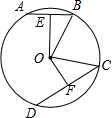问题
选择题
下列说法正确的是( )
①平分弦所对两条弧的直线,必经过圆心且垂直平分弦.
②圆的切线垂直于圆的半径.
③在同圆中,相等的弦所对的圆周角相等.
④在同圆中,弦心距越大则该弦越短.
A.1个
B.2个
C.3个
D.4个
答案

因为平分弦所对的两条弧的直线,必经过圆心,且垂直平分弦,所以第一个论述是正确的,∴①正确;
∵圆的切线垂直于过切点的半径,∴②错误;
∵在圆中,任何一条弦都对应着两条弧,而这两条弧一般是不相等的,只有弦是直径时,所对的两条弧才相等,∴③错误;
∵由垂径定理和勾股定理
得出BE<CF,
即AB<CD,∴④正确;
∴正确的有2个,
故选B.
